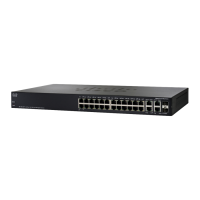Managing System Logs
Setting Remote Logging Settings
Cisco Small Business 300 Series Managed Switch Administration Guide 26
3
• RAM Memory Logging—Select the severity levels of the messages to be
logged to RAM.
• Flash Memory Logging—Select the severity levels of the messages to be
logged to Flash memory.
STEP 3 Click Apply. The switch is updated.
Setting Remote Logging Settings
The
Remote Log Servers Page
enables defining remote SYSLOG servers where
log messages are sent (using the SYSLOG protocol). For each server, you can
configure the severity of the messages that it receives.
To d e f i n e S Y S L O G s e r v e r s :
STEP 1 Click Administration > System Log > Remote Log Servers. The
Remote Log
Servers Page
opens.
This page displays the list of remote log servers.
STEP 2 Click Add. The
Add Remote Log Server Page
opens.
STEP 3 Enter the parameters.
• IP Version—Select the supported IP format.
• IPv6 Address Type—Select the IPv6 address type (if IPv6 is used). The
options are:
- Link Local—The IPv6 address uniquely identifies hosts on a single
network link. A link local address has a prefix of FE80, is not routable, and
can be used for communication only on the local network. Only one link
local address is supported. If a link local address exists on the interface,
this entry replaces the address in the configuration.
- Global—The IPv6 address is a global Unicast IPV6 type that is visible and
reachable from other networks.
• Link Local Interface—Select the link local interface (if IPv6 Address Type
Link Local is selected) from the list.
• Log Server IP Address—Enter the address of the server to which logs are
sent.

